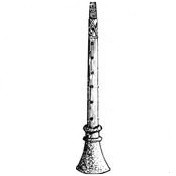bolie overview
 Polie (pinyin: bō liè) is a double-reed gas-sounding instrument of the Zhuang nationality. The Zhuang language is also called Bilie and Bielie. In Zhuang language, "wave", "bi" and "bie" all mean blowing, and "column" means pipe, which means blowing pipe. The Han people call it the Zhuang Suona. It is a folk musical instrument with a long history. After reform, it has become an excellent solo instrument with beautiful timbre and expanded range. Popular in Longzhou, Ningming, Pingxiang and Nanning in Guangxi Zhuang Autonomous Region.
Polie (pinyin: bō liè) is a double-reed gas-sounding instrument of the Zhuang nationality. The Zhuang language is also called Bilie and Bielie. In Zhuang language, "wave", "bi" and "bie" all mean blowing, and "column" means pipe, which means blowing pipe. The Han people call it the Zhuang Suona. It is a folk musical instrument with a long history. After reform, it has become an excellent solo instrument with beautiful timbre and expanded range. Popular in Longzhou, Ningming, Pingxiang and Nanning in Guangxi Zhuang Autonomous Region.The wave of the Zhuang nationality has a long history and evolved from the suona introduced from the north, but there is no historical data to test when and what generation it was introduced. In Jinlong Village, Longzhou County, Guangxi, in the home of Huang Yuzhen, an old folk artist, there was a Polie that was preserved more than 600 years ago, which is a treasure passed down from generation to generation by the Huang family. It can be seen that Polie has been circulated among the Zhuang people at the latest at the end of the Yuan and the beginning of the Ming Dynasty. The shape, structure, pronunciation principle and playing method of the wave train are roughly the same as the suona of the Han nationality, but there are some differences, such as the tube body is short and straight, the surface has no wavy curve, and the bell mouth is made of wood. Thin and small, the core is a tin tube, the cocoon is a whistle and so on.
The traditional wave train is composed of a pipe body, a pipe whistle, a core and a bell mouth (pictured), with a total height of 32 cm to 40 cm. The tube body is made of wood, mostly made of mulberry, pear or lychee wood produced locally. The upper part is thin and the lower part is thick, and the two ends are transparent. It is a hollow cone. The height of the tube is 20 cm to 26 cm. cm, the outer diameter of the tail end is 2.4 cm, and the inner diameter is 1.4 cm. There are seven circular sound holes on the front of the tube body, the diameter of which is 0.4 cm. The first hole to the end of the tube is 2.5 cm, and the first hole to the seventh hole is 16.2 cm. The distance between each hole is 2.7 cm. The appearance of the tube body is straight and smooth. The first and last ends of the tube are covered with tin hoops, which are engraved with patterns or patterns.
When playing, the body of the pipe is placed upright, holding the wave with both hands, the right hand is on the bottom, the little finger, ring finger, middle finger, and index finger are pressed by the first to fourth holes, the left hand is on the top, the ring finger, middle finger, and index finger are pressed by the fifth to seventh holes, and the mouth The oboe whistle with the tube head can be played flat or superfluous. The pronunciation is euphemistic and pleasant. It is softer and more beautiful than the suona. It is crisp and brighter than the western musical instrument oboe. Often used as a soloist or to accompany folk songs and dances. Every Zhuang folk wedding or funeral occasions, they have to play the bolet, and dance while playing.
- Chinese name:Pole
- popular area:Guangxi Zhuang Autonomous Region
- pinyin:bō liè
overview of other similar instruments
- sanyanxiao overview
- Daguangxian overview
- Leiqin overview
- hahao overview
- yandundagu overview
- Han Xiaozheng overview
- Fang Xiang overview
- guanzi overview
- zhuqin (Dao Qin) overview
- zhuiqin overview
- bangzi overview
- three-stringed piano overview
- Gehu overview
- xiao overview
- xiaokonghou overview
- Konghou overview
- Sheng overview
- suona overview
- hulusi overview
- gushao overview
 渝公网安备 50010702504639号
渝公网安备 50010702504639号